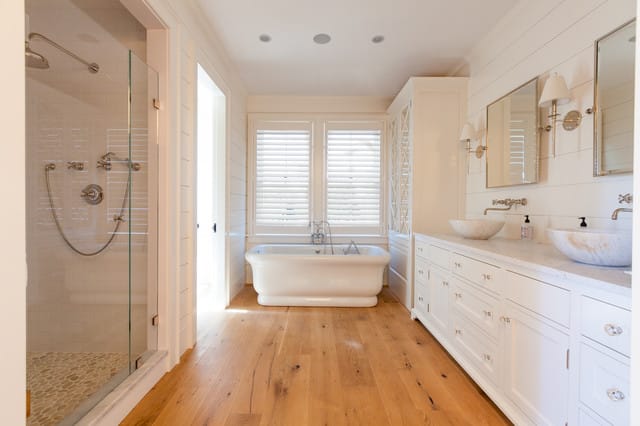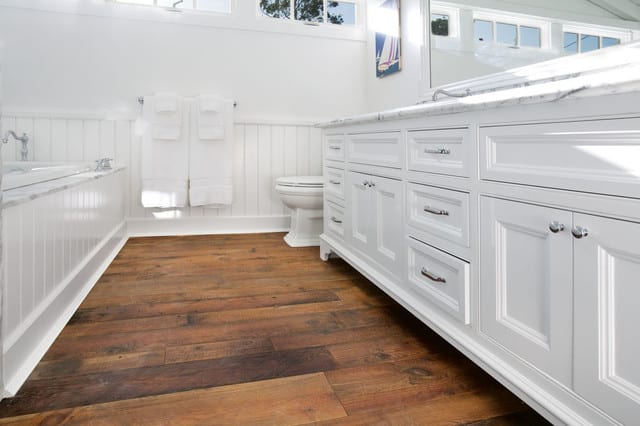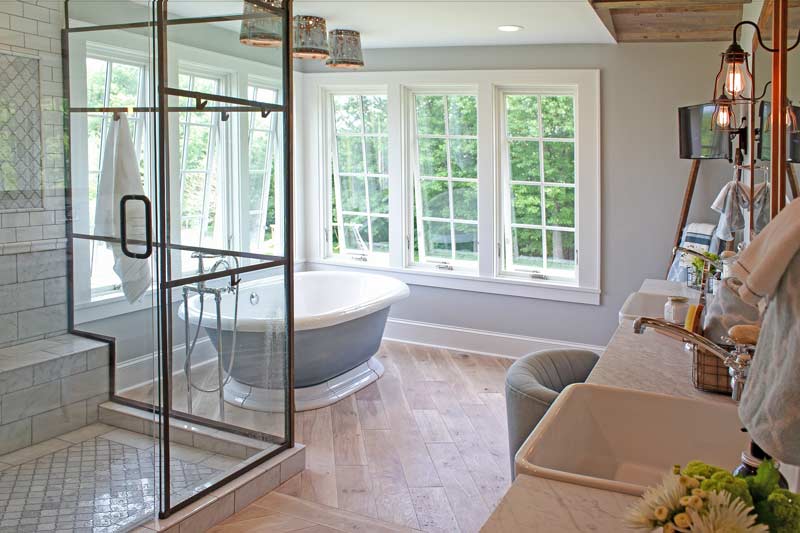Interior designers and architects will tell you that hardwood flooring is one of the most used options these days.
And why shouldn’t it be? It is sturdy enough to last for decades and looks stunning in nearly all parts of a home, can it be used in a bathroom, though?
That’s one question that needs to be analyzed in detail because the perils of water on a hardwood floor are well known.
But are those perils unavoidable and significant enough to render it unfit for a bathroom?
We decided to take a closer look at the nitty-gritty to help solve this dilemma for you. In this guide will tell you if it is a good idea to be using hardwood flooring in a bathroom.
Hardwood Flooring in a Bathroom
For the sake of brevity, we have divided this guide into four sections:
- Advantages
- Drawbacks
- Mitigating the drawbacks
- Factors to consider when buying it
Without further ado, let’s dive into the details, shall we?
Why should you use it?
Contrary to popular belief, using hardwood flooring in a bathroom offers considerable advantages, although it isn’t the best flooring option for bathrooms, people tend to use it because of the following reasons:
Aesthetic Look and Feel
Perhaps the most significant benefit of using hardwood flooring in a bathroom has to do with how beautiful it looks. Let’s face it; we want hardwood floors in almost all other parts of our homes, so why exclude the bathroom?
Those planks with grain patterns add a touch of natural aesthetics and unique appeal to any bathroom setting, and the best part is that hardwood floors need not be in line with any specific theme or color scheme. Irrespective of how your bathroom is designed, a hardwood floor will undoubtedly add to its elegance.

Longevity
It does not take rocket science to know that hardwood is one of the most durable flooring materials you can get. If you maintain it properly, a hardwood floor should ideally last for at least 25 years, thus when it comes to longevity, only stone or ceramic tiles offer a longer life.
What makes it even better is the added flexibility of sanding and refinishing it to renew and revive it, even if your hardwood floor gets scratched, you can restore it quite effortlessly.
Engineered hardwood flooring is not as durable as the original hardwood flooring but it is gaining popularity these days because of its low maintenance and cost.
Warmth
Unlike ceramic tiles which can be considerably chilly in the winter, hardwood is warmer and more comfortable to walk on barefoot. Since a bathroom is one place where you are more likely to be barefoot, it makes sense for you to use hardwood flooring in it.
Apart from the way it feels, a hardwood floor also looks warmer and more welcoming than the others. The earthy tones of hardwood make for a much better flooring option than conventional, colder tiles.
Why should you avoid using it?
If you talk to interior designers and architects, they will tell you that installing hardwood flooring in bathrooms used to be a strict no-no, even though people have started using it in bathrooms today, some downsides to it should not be ignored.
Floor Slope
Gravity can be a significant hindrance when you’re dealing with a hardwood floor in a bathroom. If the bathroom floor is not perfectly level, you will see water flowing from the higher to the lower areas and accumulating there, even if there is a drain in the lower area, there would be some water just sitting there till it is mopped dry.
These puddles of water are incredibly harmful to hardwood floors. The moisture tends to seep through the seams and compromise the structural integrity of the planks, if your bathroom subfloor is not perfectly level, you should steer clear of hardwood flooring options.
Mold and Mildew
Mold and mildew grow in moist environments, making any bathroom susceptible to these problems, if you have ever had to deal with them, you know that they feed on natural organic materials, and wood flooring is not fit for every space. Using hardwood flooring in a bathroom might, sooner or later, force you to deal with mold and mildew.
While the protective layer of a sealant may be able to delay it for a bit, it will eventually grow between as well as beneath the boards. If you are prone to get allergies and are sensitive to mold, you should think twice before using a hardwood floor in the bathroom.

Chemical Staining
You use several types of cleansers, soaps, and other body grooming products in the bathroom. Each of these products contains chemicals, some of which may very well be slightly acidic, when these products spill on the hardwood floor, they will damage the protective finish and eventually cause permanent stains.
We recommend paying particular attention to powerful cleansers and avoiding spilling them on the floor because they tend to do the most damage. If at you end up dropping some of it, be sure to clean it thoroughly and quickly.
High Humidity
If you were to select one part of your home as the most humid, it would most likely be your bathroom, while most people proactively take care of spilled water, they seldom focus on implementing measures to reduce the level of humidity.
But is a highly humid environment truly terrible for hardwood flooring? As it turns out, the answer to that question is a resounding yes!
For those of you whose bathrooms are not properly ventilated, you must be familiar with the steamy fog on the mirror, all of that moist and warm air does not just settle on the mirror. It fills every crack and penetrates tiny spaces, including the gaps between adjacent planks.
Any bathroom will experience /twists, cracks, and warps in its hardwood floor because of high humidity.
No Moisture Barrier
The majority of hardwood floors are installed directly on the subfloor by nailing the planks, so you can say goodbye to the traditional vapor barrier because the nails would puncture it. How is that bad, you may be wondering, well, it leaves the subfloor and underlayment exposed to any moisture that may seep down the hardwood surface. Gradually, the lack of any moisture barrier will lead to the deterioration of the structural integrity of the foundation.
To cut a long story short, a bathroom should have only those hardwood flooring options that can be installed using the click-together method or with adhesives.
Spills and Splashes
Spilling and splashing water onto the bathroom wooden flooring is more a matter of “when” than “if.” And it becomes quite a frequent hassle when there are kids in the family. We aren’t talking about the shower or bathtub area only, but also near the sink, something as simple as washing your face could send water droplets spilling onto the floor below.
So how does this inevitable, recurring hassle affect hardwood floors? Even if it is sealed with a finisher, it is not immune to moisture damage and will eventually start showing the effects. It will wear away at the protective coat of the finisher and may seep down through the seams.
That’s why you will find that most of the warranties of hardwood floor sealants are void if you do not wipe up spilled water immediately.
Accidental Flooding
A bathroom is one place in a home that is prone to flooding, thanks to the several plumbing fixtures needed for it to function. It is not unheard of that a pipe starts to leak or a fixture malfunctions in a bathroom, having a hardwood floor would only make the problem worse for you.
In the unfortunate event of accidental flooding of several inches in the bathroom, your hardwood floor can get severely damaged, even if you get rid of the water quickly and mop it dry, it is not strong enough to withstand a flood.
As a rule of thumb, you should replace old pipes and plumbing fixtures before installing hardwood flooring in a bathroom.
What can you do to prevent damaging it?
Now, we know what you must be thinking at this point – the downsides seem more significant than the benefits. But do not jump to that conclusion because there are measures you can take to eliminate some of those downsides. Here are all the things you should be doing to preserve and maintain hardwood flooring in a bathroom.
Maintain Plumbing Fixtures
The first step you can take to preserve the hardwood floor in your bathroom has to do with maintaining the plumbing fixtures. There are no gimmicks or shortcuts here; you would have to be on your toes and proactively check for any drips or leaks.
Be it the visible fixtures or the hidden pipes, a leak will lead to water damage. For starters, you should ensure that each of the pipe openings is correctly caulked. Moreover, pay attention to the areas that are more prone to leaks, like the valve connections beneath a pedestal sink or toilet.
If you maintain the plumbing fixtures optimally, you can drastically reduce the chances of accidental flooding or severe leakage.
Place Bath Mats
This next measure is perhaps the simplest yet most effective of the lot. We strongly advise using bath mats in strategic spots of the bathroom to catch splashes, spills, and drips.
Keeping a mat outside the shower enclosure or bathtub will ensure that water from your feet does not drip down onto the hardwood floor. Likewise, you should consider placing one near the sink to act as a barrier for splashes and spills.
If you are buying bath mats, we recommend going for those that have durable vinyl or rubber backing. These mats will not slip on the hardwood floor and also keep moisture from passing through.

Install Tub and Shower Surrounds
One way to preserve the hardwood floor in your bathroom and enhance the interiors simultaneously is by installing perimeter surrounds for the bathtub or shower. You can easily take your bath up a notch by matching the surroundings with the overall theme and style.
It is one of the most effective ways to keep water away from wooden flooring. But the only caveat is that you would have to seal the joints and cracks carefully for it to be foolproof.
But we cannot deny that it may not be viable to install surrounds in every bathroom, because of the layout and space. Moreover, it is one of the more expensive options, so people may be a bit reluctant to go for it.

Regular Maintenance
The next step is one of the most obvious things you should be doing. And yet, the majority of homeowners tend to overlook it. The hardwood floor in your bathroom will not last if you don’t maintain it. In fact, even if you implement all the other measures we have recommended in this guide today, you should still be maintaining the floor itself.
Think of the sealant or finisher as your first line of defense against water damage. And we recommend applying a fresh coat of it regularly, ideally once every couple of months. Also, you should pay attention to the cracks between boards.
You can test the quality of the sealant layer by dropping a small amount of water and observing how it behaves. If it beads up, the coating is still intact; if it sinks in, you need to apply another coat immediately.
Ventilation
Before moving on to the factors you should be considering when buying a bathroom, we want to talk about an age-old technique for preventing water damage. If a bath is well-ventilated, its hardwood flooring will last longer.
Simple things you could incorporate into your daily habits include keeping the windows and door open after bathing, or running an exhaust fan while you’re in there. Some people even install a regular fan in the bathroom to keep it ventilated.
Soundproofing and Energy Efficiency Considerations
While hardwood floors are known for their aesthetic appeal, they also offer notable benefits when it comes to soundproofing and energy efficiency. The solid structure of hardwood helps reduce the transmission of sound by absorbing and dispersing sound waves, making hardwood an effective choice for noise reduction. This quality can be particularly beneficial in busy households or multi-story buildings where noise transfer can be a concern.
In addition to its soundproofing capabilities, hardwood also contributes to the energy efficiency of a home. Hardwood floors have inherent insulating properties and can effectively retain heat, thus reducing energy consumption for heating during colder months. To further enhance these attributes, homeowners can also opt for specific soundproofing solutions like underlayment materials for hardwood floors.
When combined with regular maintenance and mindful usage, hardwood flooring can offer a harmonious balance between aesthetic appeal, acoustic comfort, and energy efficiency. This consideration makes it important to consider not only the visual aspect but also the functional benefits when selecting hardwood flooring for your home.
What are the factors you need to consider when buying it?
We have talked about the pros, cons, and ways to address some of those cons. And it is time to answer some critical questions you will likely face when you decide to buy hardwood flooring for the bathroom. These are the factors you must consider while choosing the perfect hardwood flooring option.
Type
You will find various kinds of hardwood flooring options out there. But not all of them are ideal for a bathroom environment, so you need to know which type to buy.
You need to avoid softer variants like fir and pine due to their lower density and increased chance of absorbing moisture. The most suitable types that you should consider are oak, teak, maple, cedar, hickory, ash, cherry, and walnut.
We suggest you take a look at this quality wood flooring to get a better idea of the different types you should be considering.

Finish
Irrespective of the type of wood flooring you choose, if it does not have a protective layer of finish or sealant, it will warp, stain, and expand in contact with liquids. And that’s because wood is inherently very absorbent. So, it becomes a necessity for you to seal wood flooring with a protective finish.
You would have to apply coats of a sealant at regular intervals to ensure that the high moisture exposure does not damage the floor. Moreover, you should focus on sealing the seams because water will most probably penetrate through them.
Polyurethane-based sealers are among the most popular finishing agents on the market today. As long as you are buying a product that is designed explicitly for moist environments, you need not worry.
Warranty
We want to set the record straight and tell you that no hardwood flooring option comes with a warranty that covers water damage. In fact, most of the options will come with warranties that explicitly state a stipulation to render them void in a bathroom.
And that’s why you must focus on the warranty information of the option you are considering. The last thing you would want is to buy a product whose warranty comes with overly stringent terms and conditions. Some warranties will hold as long as you wipe the floor immediately after a spill or drip.
Summing It Up
Now that we have reached the end of this comprehensive guide, we won’t beat around the bush. Using hardwood flooring in a bathroom means more work on your part to maintain it. But is it worth all that additional effort?
We like to believe it is.
Think of it this way – anything worth having doesn’t come easily! Hardwood flooring speaks of sheer class and can make your bathroom stand out from the others.
Having said that, we hope this guide was able to answer most, if not all, of your wood flooring questions. Let us know in the comments section below about your experience using hardwood flooring in a bathroom.
Till next time!
Related Articles
7 Types Of Flooring To Consider For Your Home
Bathroom Wainscoting – What It Is And How To Use It?
13 Best Bathtub Faucets Right Now
8 Hardwood Maintenance Basics You Need for For Spotless Floors
10 Pros and Cons of Hardwood Flooring You Should Know
How to Clean Floors – Tips & Tricks for a Spotless Floor
40 Types of Engineered Flooring | Pros, Cons and Costs



